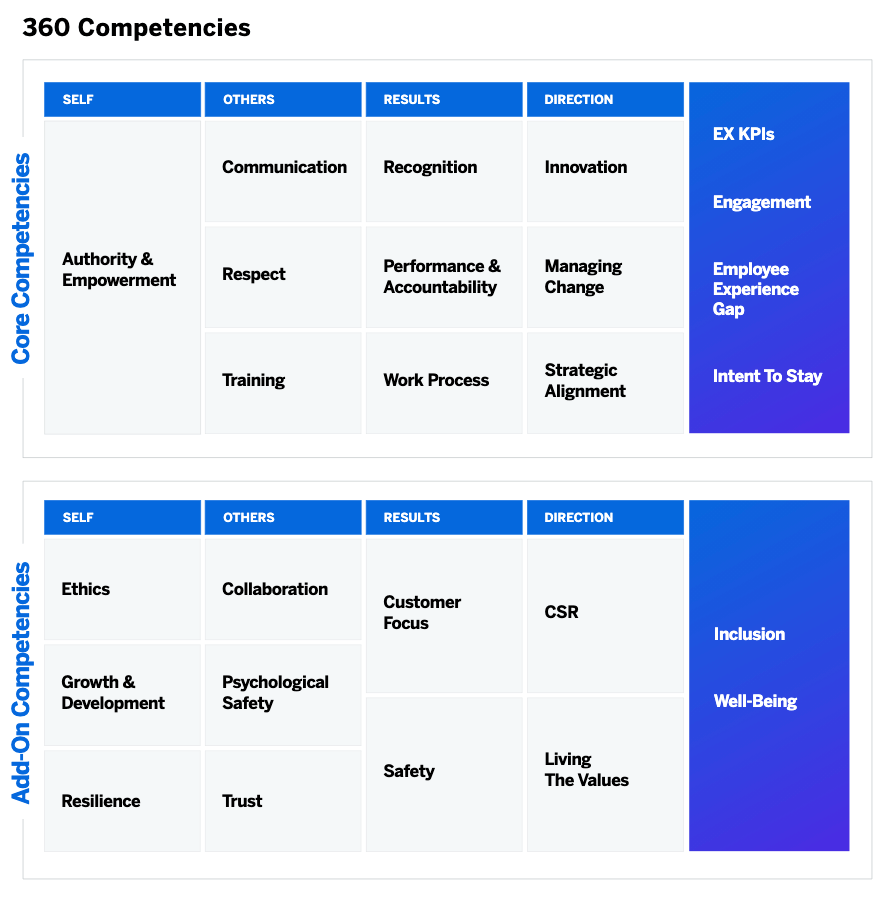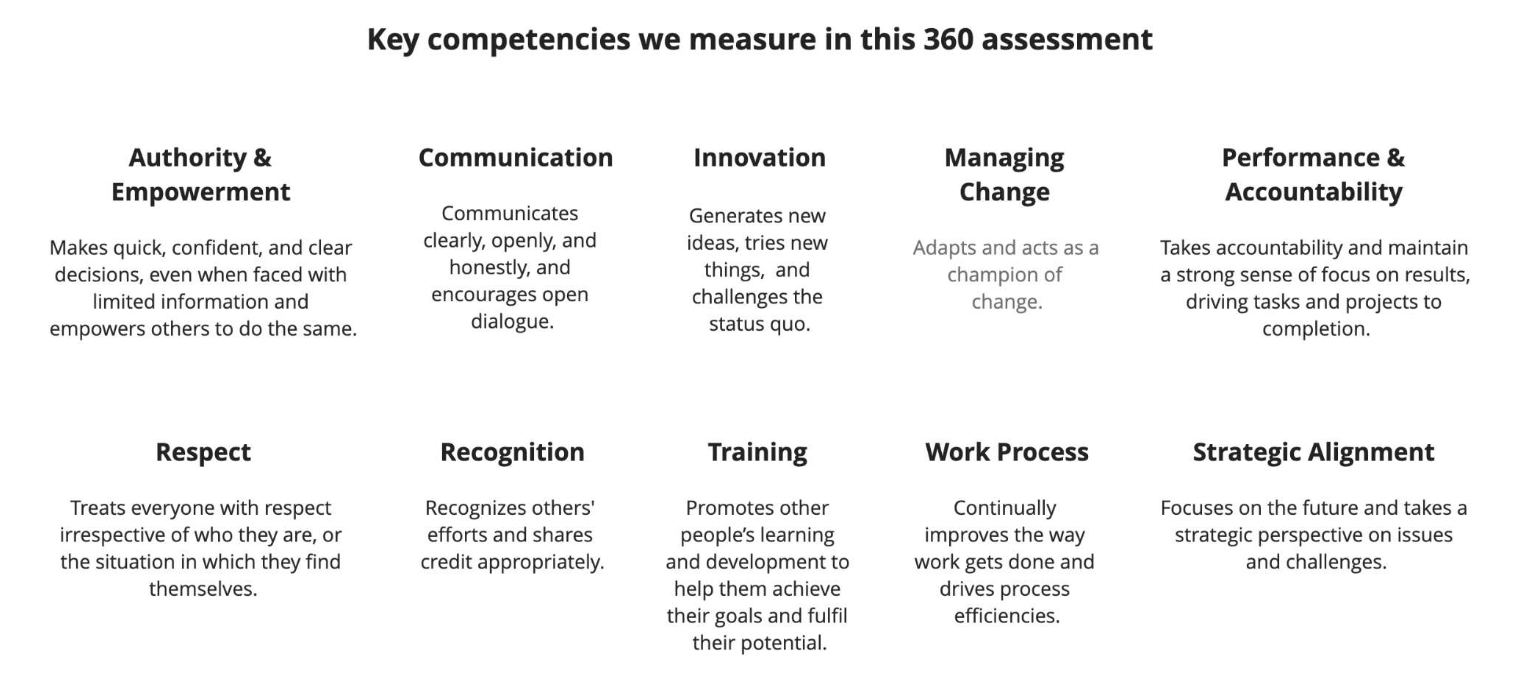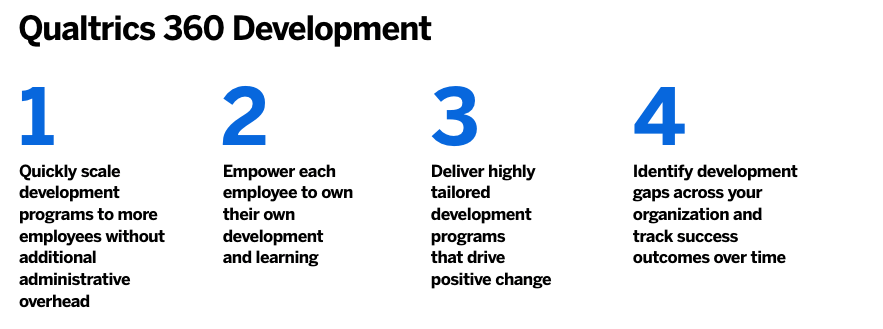What’s the key to good 360 feedback questions?
Feedback is crucial to understand how an organisation’s employees are supported by management and assisted in their development. For an employee, it’s useful to understand how their work and efforts are being perceived by others, and how they can gear their efforts towards greater improvement. This is why the 360 degree feedback exercise is vital for any human resources toolkit.
Yet, there’s a difference between employees receiving poor feedback and good feedback. Poor feedback can negatively affect relationships between staff and managers, while also wasting the full potential of the 360 Development solution. Good feedback can take results and apply the learnings and results constructively to the employee, helping them connect with the organisation and want to do better.
It’s important that 360-degree feedback questions:
- Are relevant to the person being investigated — Peers, line managers, and direct reports are examples of useful relationships that can have a say about an employee. Getting feedback from people that aren’t relevant working relationships to the employee will bring up irrelevant data.
- Are focusing on an employee’s attributes, not solely on performance — Employee behavior is what we’re reviewing here in a way that can be broken down by non-KPI standards (e.g. the employee’s communication, motivation, or interpersonal skills.
- Are seen as ways to discover a person’s ‘blindspots’ —The questions should not be attacking or leading. Instead, they should ask for an evaluation without bias.
How to write a good 360 feedback question
In order to get the right data, 360 feedback questions must be written in the right way. Here are some things to consider when choosing your questions:
- The framing of the question — Is the question fair and non-judgemental? Does it provide a large range of responses that a participant can answer without leading or influence?
- Choose a specific question that focuses on one competency at a time — Trying to measure more than one attribute area can confuse the participant and lead to unclear results.
- The language in the question — Does the question use the primary language of your audience? Is there overly complex language, jargon, or technical language that will prevent understanding?
When considering if the final question selection hits the mark, ask yourself if the questions offer:
- Relevance to your organisation — Is the final question selection fairly covering all the driving factors or employee attributes that you want to explore for your organisation? Below is a list of the 360 competencies that we’ll explore as part of our 360 Development solution.

- Relevance to the role — Does the final question selection have more than 8-10 competencies? Don’t exceed this number as the feedback should be focused around the core areas for that job.
- An easy to complete process — Is the final question selection user-friendly to read, understand, and complete? To avoid survey fatigue, it’s recommended not to exceed more than 30-40 questions.
Closed-ended vs open-ended feedback question examples
Most questions used in 360-degree feedback are close-ended questions that have a specific answer range (yes/no, 1-10, etc). This does make data collection easier to collect and analyse in quantifiable ways, meaning comparisons are also easier to do.
However, open-ended questions also have a part to play in employee feedback. This gives the opportunity to understand why results have been provided, information that can’t be captured in numerical form, and provide details that aren’t covered by the available questions.
You can make open-ended questions as mandatory or optional questions to carry out by the participant, though optional may limit the comments and qualitative feedback, which is valuable for understanding results and specific use cases.
360 feedback question examples by type
360 feedback questions for managers
These close-ended questions are useful for adding to management 360 feedback reviews, to ask relevant questions for this particular role.
- Does the manager work in a respectful manner to others?
- Does the manager consider other team members’ opinions before making a decision?
- Does the manager effectively solve problems?
- Is the manager responsive to their team’s needs and questions?
- Can the manager work under pressure to meet deadlines?
- Does the manager provide a clear vision that aligns with the organisation’s objectives?
Leadership
These close-ended questions are great to understand the leadership abilities of the employee.
- Does the employee provide solutions to difficult customer problems?
- Is the employee demonstrating leadership on a daily basis?
- Does the employee take accountability for the work and carry it out to the deadline?
- Do other team members look to the employee to help them with their work?
- Does the employee carry out duties without issue?
- Does the employee bring ideas to the table when problem-solving?
- Does the employee supervise work to an effective level?
Communication
These close-ended questions are used to understand how well an employee communicates.
- Does this employee listen well to others’ suggestions?
- Does the employee communicate effectively with customers/managers/peers?
- Does the employee ask for more information if they do not understand something?
- Does the employee communicate well in writing with good grammar and spelling?
- Does the employee speak in a clear and concise way?
- Does the employee effectively communicate their ideas to others?
- Does the employee create opportunities for discussion and dialogue?
Interpersonal skills
These close-ended questions are used to understand how well an employee can form and nurture relationships within the organisation.
- Does this employee work well with others on tasks?
- Does this employee show respect to others in their team?
- Does the employee manage their emotions and keep them in check?
- Does the employee effectively manage their stress levels?
- Does the employee regularly have conflict with others?
- Does the employee exhibit the core people values of the organisation?
- Does the employee collaborate with others effectively in a team?
- Is this employee someone that other staff will turn to for advice?
Problem solving
These close-ended questions are used to understand how well an employee can examine a problem and find a suitable solution.
- Is the employee effective at evaluating a problem?
- Does the employee suggest useful solutions to a problem?
- Does the employee recognise when there is a problem?
- Does the employee effectively communicate the problem to others and bring them on board?
- Is the employee able to work independently to fix a problem?
- Does the employee feel confident in exploring problems without assistance?
- Does the employee provide creative solutions to problems?
- Does the employee understand the impacts and dependencies of a problem?
Organisational alignment
These close-ended questions look at how an employee reacts to the organisation’s goals and values.
- Does the employee know about the organisation goals?
- Does the employee know about the organisation’s strategic vision?
- Does the employee live the company values daily?
- Does the employee discuss the company in meetings?
- Does the employee recommend the company to customers?
- Is the employee showing engagement with the organisation goals?
- Does the employee actively feedback about organisation ideas or activities?
Employee’s Motivation
These close-ended questions look at how an employee’s motivation levels for the work and their own role.
- Does the employee appear to be motivated by their job?
- Does the employee communicate that they are motivated with their job?
- Is the employee difficult to motivate to do a task?
- What is the level of motivation that the employee shows?
- Is the employee motivated to independently share their work with others?
- Does the employee motivate others in a group task?
Efficiency
These close-ended questions look at how an employee reacts to the organisation’s goals and values.
- Does the employee complete their tasks effectively?
- Does the employee create a sense of collaboration when working with others?
- Does the employee deal with daily work tasks effectively?
- Is the employee’s work finished to the right level every time?
- Does the employee complete their work on time?
- Does the employee provide high standards in their work?
- Does the employee exceed expectations with their work?
- Does the employee improve processes to make them more effective?
Open-ended questions for 360 degree feedback reviews
Where you decide you want to add in open-ended questions, you can add these in after each question to find out specific reasons why participants answered in the way they did, or at the end of the close-ended questions, to give summaries or final thoughts outside of the selection of close-ended questions. Some examples include:
- After each close-ended question
- Please elaborate more on your answer?
- Why have you answered this question in this way?
- At the end of all close-ended questions
- What else would you like to share about this employee?
- What has this employee done particularly well?
- What would make this employee more effective in their role?
- What other comments do you have?
- Are there any attributes that have not been covered that you’d like to associate with this employee?
- Can you provide specific examples?
- What skill level have they demonstrated within [add attribute]?
360 Feedback Best Practices Guide eBook: Download Now
Sample 360 feedback question on core competencies:
Here’s a 360 Feedback template for asking someone about a colleague’s employee performance. These best practice examples can help you get started on your survey, or benchmark what you’re currently doing.
Each section of the template focuses on a different attribute: In this case, Communication, Strategic Mindset, Decision Making, and Leading the team.
Hello (Evaluator Name),
You’ve been asked to provide employee feedback in this 360-degree survey for (Subject Name).
Below are some key leadership principles that apply to (Subject Name)’s development.
Please provide your confidential feedback by answering the following questions:
Communication
Please rate (subject’s name/yourself) relative to peers:
| Never | Rarely | Occasionally | Often | Always | No Opportunity to observe | |
| Tailors communication to the needs of the audience | ||||||
| Checks for understanding when communicating with others |
What are 1-2 ways (SUBJECT) can improve in this area?
What are 1-2 things (SUBJECT) does well in this area?:
Strategic mindset
Please rate (subject’s name/yourself) relative to peers:
| Never | Rarely | Occasionally | Often | Always | No opportunity to observe | |
| Sets a clear strategy for achieving goals | ||||||
| Adapts and aligns with changes in business priorities |
What are 1-2 ways (SUBJECT) can improve in this area?
What are 1-2 things (SUBJECT) does well in this area?:
Decision making
Please rate (subject’s name/yourself) relative to peers:
| Never | Rarely | Occasionally | Often | Always | No opportunity to observe | |
| Considers the impact of decisions prior to action | ||||||
| Involves the right stakeholders when making decisions | ||||||
| Takes initiative to solve problems | ||||||
| Motivates others to reach their goals |
What are 1-2 ways (SUBJECT) can improve in this area?
What are 1-2 things (SUBJECT) does well in this area?
Leading the team
Please rate (subject’s name/yourself) relative to peers:
| Never | Rarely | Occasionally | Often | Always | No opportunity to observe | |
| Creates an environment where everyone can succeed | ||||||
| Promotes visibility to the contributions and work of the team |
What are 1-2 ways (SUBJECT) can improve in this area?
What are 1-2 things (SUBJECT) does well in this area?
Qualtrics solutions that make 360 feedback easier
Organisations that use such a 360 review process can be overcome with data and may have problems taking the next steps to analyse and communicate results.
Qualtrics has “built for purpose” technology helping participants of the 360 program:
- Provide feedback that is honest, authentic, and actionable without the fear of attribution back to the rater.
- Provide assurance to subjects that the 360 program’s primary purpose is growth and development of employees so that it can mitigate any associated fears related to career development or reputational cost.
- Use 360s for development only and allow participants to choose their own evaluators so that they can co-create the process
- Provide 360 Dashboards that are unique to the Qualtrics’ solution to give HR and People Analytics leaders the opportunity to identify areas of strengths and deficiencies across the organisation as a whole.
- Filter data in real-time to identify development gaps across an organisation, based on job level, role, tenure, geography, and other embedded data.
- Help directly feed results into your human resources, learning, and development strategies and help you make development decisions with greater speed and confidence.
- Quickly identify development gaps across your organisation.
It covers all key competencies:

And is administered in four stages:

Run 360 feedback surveys with Qualtrics

This article was written by the EmployeeXM team
Our EX Scientists are a global team of Employee Experience consultants who deliver advisory services for our clients to help them design and deliver world class EX strategies & programs. They provide empirically driven, best practice solutions.